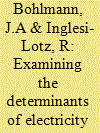|
|
|
Sort Order |
|
|
|
Items / Page
|
|
|
|
|
|
|
| Srl | Item |
| 1 |
ID:
168672


|
|
|
|
|
| Summary/Abstract |
The literature has always shown that there are two important factors in the improvement of a country's research output: Gross Domestic Product (GDP) and R&D Expenditures. Taking the discussion a step further, and in an effort to provide policy recommendations on what is needed to boost research capacity, this paper aims at decomposing the change in energy research papers of five countries (Australia, Canada, Germany, UK and US) into four factors: GDP, R&D intensity (ratio of total R&D to GDP), energy R&D rate of return or productivity (number of energy-related papers per unit of energy R&D expenditure), and energy R&D priority (share of energy R&D to total R&D expenditure).
|
|
|
|
|
|
|
|
|
|
|
|
|
|
|
|
| 2 |
ID:
105788


|
|
|
|
|
| Publication |
2011.
|
| Summary/Abstract |
In South Africa, the electricity mismatch of supply and demand has been of major concern. Additional to past problems, the 2008 electricity crisis made the solution crucial after its damaging consequences to the economy. The disagreement on the need and consequences of the continuous electricity price hikes worsens the situation.
To contribute to the recent electricity debate, this paper proposes a time-varying price elasticity of demand for electricity; the sensitivity of electricity consumption to price fluctuations changes throughout the years. The main purpose of this study is the estimation of the price elasticity of electricity in South Africa during the period 1980-2005 by employing an advanced econometric technique, the Kalman filter.
Apart from the decreasing effect of electricity prices to consumption (-71.8% in the 1990s and -94.5% in the 2000s in average), our results conclude to an important finding: the higher the prices (for example in the 1980s) the higher the sensitivity of consumers to price fluctuations.
Thus, further increases of the electricity prices may lead to changes in the behaviour of electricity consumers, focusing their efforts on improving their efficiency levels by introducing demand-side management techniques or even turning to other sources of - cheaper - energy.
|
|
|
|
|
|
|
|
|
|
|
|
|
|
|
|
| 3 |
ID:
175899


|
|
|
|
|
| Summary/Abstract |
For the period 1975–2016, this paper examines the determinants of the residential demand for electricity in South Africa including disposable income, electricity prices, food prices as well as the impact of the 2007/08 load-shedding wave and the 2008 electricity price restructuring. Given the high income inequality levels in South Africa, this relationship was investigated at aggregated and disaggregated income levels. Based on an Autoregressive Distributed Lag (ARDL) model, the empirical results indicate long-run cointegration between residential electricity consumption, gross national disposable income, electricity prices and food prices. Disposable income elasticities have a positive sign for the aggregate and all income groups, indicating that as income increases, South African households consume more electricity (normal good). As expected, price elasticities are negative and significant – for both the aggregated and disaggregated models – indicating that electricity prices do influence electricity demand for all South African households. The paper also examines the complementarity or substitutability of food and electricity. At both the aggregated and disaggregated income levels, the results showed that food and electricity are substitute goods for all South African households. However, as expected, the magnitude of this relationship is marginally different for each income group.
|
|
|
|
|
|
|
|
|
|
|
|
|
|
|
|
|
|
|
|
|